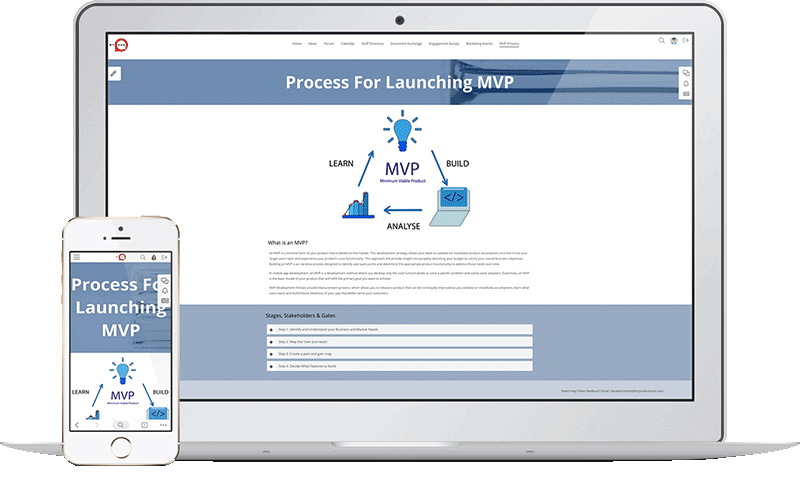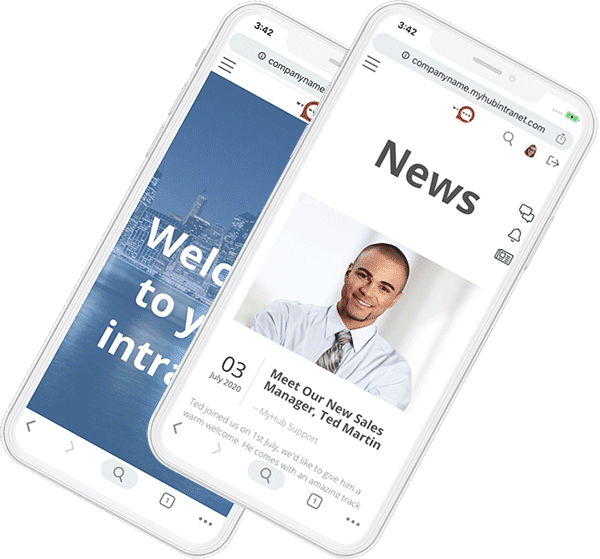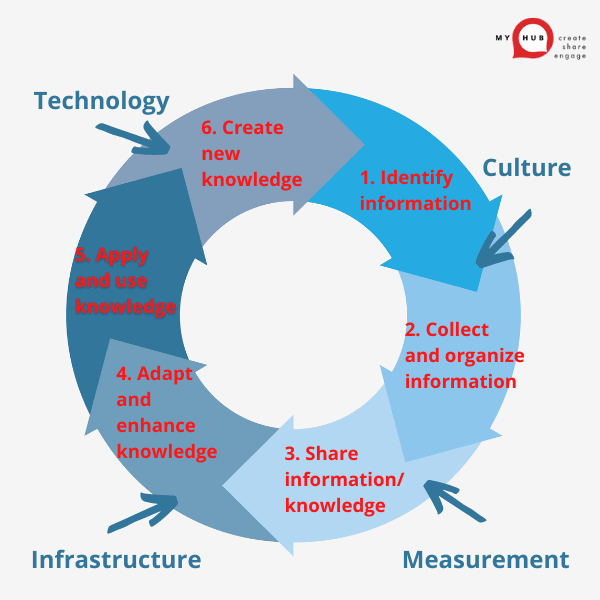Knowledge Transfer
Nurture The Transfer of Knowledge Internally With MyHub Intranet

- Stop company knowledge walking out the door when an employee leaves
- Create a team-learning culture for continuous improvement
- Save time and prevent staff reinventing the wheel
Share Wisdom. Reduce Risk
Stop the standstill when the only person who understands a critical part of your business leaves. Retain and transfer knowledge within MyHub:
- File storage and file sharing
- Social intranet features
- Easy-to-use pages
- Team Chat
- Staff directory and calendar
Entry-level pricing. No IT skills required. Perfect for small-to-medium size companies.

One Solution. Many Benefits
Discover How MyHub’s Intranet Software Supports Knowledge Transfer
Keep All Your IP Under One Virtual Roof
Say goodbye to missing paperwork, lengthy emails, and lost messages
Help Knowledge Rise Up
Enable internal experts to formally capture their wisdom, in multi-format ways
Work As A Team
Promote a true team spirit with tools that make communicating and sharing information easy
Let Information Flow
Simplify how important company information is relayed
Support Decision-Making
Expedite decisions with organized and up-to-date files at your fingertips
Teach Processes To New Employees
Ensure health and safety, compliance, HR and other important policies are easily available
Create A Knowledge Culture
Establish a rolling plan for replacing, updating and building company knowledge
Remote Access To Knowledge
Provide a simple and secure way for staff to access and share information, wherever they’re based
Intranet For Knowledge Transfer
All in one place. All for one small fixed fee.
Fast Search
Empower staff to locate information fast with advance search
Notifications
For important updates and quick message distribution, to a single user or groups
Forums
Collaborate, problem-solve and exchange knowledge
File Sharing
Secure, central space in the cloud for document storage
Newsletter
Document and share knowledge via this favorite channel
Staff Directory
Help staff locate internal experts: contact details, bios, headshot + more
Feedback
Invite feedback and ideas from all corners of the business
Template Library
Large range of pre-built templates to help with common tasks
Instant Messaging
Make communicating between each other more effective and much easier
Activity Wall
Consolidate company news, latest updates, team announcements
Quiz + Survey
Gain insights into employees’ proficiency to guide training
Auto Workflows
Eliminate tedious, time-consuming admin tasks and free up time
Top Rated in Customer Reviews




Why Businesses Must Transfer Knowledge
Less Searching. More Learning
The transfer of knowledge within an organization is often a poorly recognized issue. Few businesses have approached knowledge transfer in any systematic way.
Usually, an ad hoc approach involving a hastily arranged exit interview or a quickly drawn up handover checklist is the sum total of knowledge transfer when an employee leaves. And yet it’s been estimated that up to 10,000 people retire every day in the US. That’s a lot of company knowledge that’s walking out the door.
And what about key staff members that leave unexpectedly? What happens to their knowledge and expertise? This represents a significant drain of a company’s collective wisdom and can impact on overall innovation, growth and efficiency.
Introducing a knowledge management strategy – including mechanisms to capture and transfer critical company information – makes good business sense.
But how do you go about organizing and managing knowledge transfer in your business? When your in-tray is already jam-packed with priorities and tasks, getting started is a challenge.
This article will help you to kick-start the knowledge transfer process. We cover all you need to know including:
- types of knowledge transfer
- the importance of knowledge transfer
- knowledge transfer examples
- tools to help you share knowledge including a knowledge transfer checklist.
Read on for a comprehensive look at knowledge transfer and how to achieve it.
Types Of Knowledge Transfer
Understand The Two Main Elements To Knowledge Transfer
Knowledge transfer is all about staff members sharing their wisdom, experience and specific occupational knowledge with their colleagues on the job. It’s about finding ways to transfer the knowledge within people’s minds into a system where it can easily be stored, shared, referenced and used by all employees. Essentially, it’s about getting the right information to the right people at the right time.
There are two main elements to knowledge transfer: explicit knowledge; and tacit knowledge.
Explicit Knowledge
Explicit knowledge is the type of information that you find in manuals or databases. It can be readily articulated and is relatively easy to transmit. So, for example, the steps an employee needs to take to complete a task such as setting up a new supplier on the system would be an example of explicit knowledge.
Tacit Knowledge
Tacit knowledge includes things like what issues or problems to look out for; when to ask for help as well as on-the-job experiences and creative solutions. This knowledge-type is usually accumulated over many years. This more intangible type of knowledge is what businesses are struggling to retain and preserve.
Knowledge Management
Closely aligned to knowledge transfer is knowledge management. In fact, the cataloging and storing of the information that knowledge transfer involves is an essential first step in developing a systematic approach to knowledge transfer.
With so much accumulated data and information within a business, a comprehensive approach to knowledge management is essential to ensure employees can access what they need to when they need it.
And so, as well as looking at ways to transfer knowledge, businesses must also develop an overarching knowledge management strategy to manage and disseminate that know-how throughout the company.
Importance of Knowledge Transfer
The spotlight has been placed on knowledge transfer largely because of the great number of baby boomer generation CEOs, corporate leaders and experts that have already retired or will be doing so in the near future.
Don’t let new staff repeat old mistakes
The truth is that younger workers can’t necessarily fill the void. They don’t have the same depth of experience or accumulated wisdom that comes with many years of working, learning and developing. In addition, younger workers tend to change jobs more frequently than their older counterparts. All this amounts to a significant drain on organizational wisdom which in turn affects the business’s capacity to grow, innovate and remain competitive.
Benefits Of Knowledge Transfer
Productivity, Agility, Responsiveness
Does knowledge transfer impact on a company’s productivity and profits?
Think for a moment about what would happen in your business if the only person who understands a critical process were to leave? How much time, resources and lost productivity would be involved in training and equipping a new member of staff to replace that individual?
We all know of those instances where a colleague retiring after 40 years in the company leaves a massive void simply because that person has so much accumulated knowledge about the business. Imagine how much more agile and responsive your business would have been if there had been a clear process to transfer that colleague’s critical knowledge.
A manager in NASA aptly summed up this all too familiar scenario when they said that if we wanted to go to the moon again, then we would be starting from scratch because all of that knowledge has disappeared.
The bottom line is that knowledge transfer within a business can contribute to increased productivity, agility and adaptability as well as ultimately profits and growth. It will support faster and more accurate decision-making and underpins sustainable high performance. And it will also make your business more responsive and will enhance the overall customer experience, thereby supporting your company’s customer retention and growth strategies.
In today’s overcrowded, global marketplace, operating more efficiently and effectively is the key to maintaining a competitive advantage. And knowledge transfer and knowledge management are critical elements of this.
Effective Knowledge Sharing
Leveraging The Combined And Unique Skills Of A Diverse Team
The transfer of knowledge is affected by a number of factors including organizational ones as well as the preferences of both the sources and receivers of knowledge within the company.
If the transfer of knowledge is to be effective in your business, then the essential starting point is an organizational commitment to the whole process.
There has to be a knowledge-sharing culture. All corners of the business must be on board with the importance of knowledge sharing. What’s more, there needs to be an understanding that company knowledge is owned by the business collectively and not any individual employee.
In addition to the organizational factors are those relating to the employees themselves. Every workforce is made up of a variety of individuals of differing ages, learning styles and preferences. Some people are more comfortable with technology than others, while other people respond better to visual information rather than written text. It’s this great diversity which generates the dynamic, creative workforce that makes your company so good. However, it’s this very diversity that makes knowledge transfer such a challenging area.
And so before you can develop an effective knowledge transfer system, you must first decide from an organizational perspective exactly who knows what – and who needs to know what. And once you’ve done that, you need to then determine how that information will be captured and transferred. And within that process, you need to understand the intergenerational differences and the preferred learning styles of sources and receivers of information.
Other companies have tackled these issues, see how with the following examples, before we look at the practical tools you can utilize to support the process.
Knowledge Transfer Examples
Strategies For Sharing Wisdom
Knowledge transfer can be a complex process – especially concerning the transfer of tacit knowledge.
Not only do companies have to be clear about what kind of knowledge is critical for the business to capture, they also need to take account of inter-generational differences.
Different generations and individual employees in the workplace will have different preferences when it comes to learning. This applies to both the sources and receivers of information.
Therefore, there’s no one size fits all solution and companies have found themselves developing a number of strategies in response to specific needs and the learning preferences of different cohorts of employees.
These strategies have included the following:
- Experts’ blogs
- How-to videos
- Wikis
- Webinars
- Podcasts
- Mentoring and coaching arrangements
- Simulations and games
- Communities of practice
- Standard operating procedures
- Apprenticeships
- Frequently asked questions on intranet sites
Knowledge Transfer Checklist
Practical Tips To Harvest And Transfer Knowledge
This is a great starting point to identify the information and data you need to capture and it ensures that you don’t inadvertently miss out on any key steps.
Below is a suggested template to use and adapt to your own requirements.
It can be used to capture knowledge in relation to a process, skill or task – and not just for a particular jobholder or role. In addition, the knowledge transfer method will be influenced by the source of the knowledge as well as the recipient and by what’s possible within your business depending on its size and capabilities.
Free Knowledge Transfer Checklist Template
Our Knowledge Transfer Checklist is available as a Word document or PDF download.
Knowledge Transfer Checklist – Word format
Knowledge Transfer Checklist – PDF format
| Name | Job role/area of expertise/process/task/skill | Knowledge transfer method |
| Overview | A brief overview of the context and the knowledge transfer that is being conveyed. | |
| Objectives & responsibilities | A summary of the overall objectives and responsibilities of the jobholder or the task, process or skill. | |
| Deliverables | In relation to a jobholder, this encompasses detailed information on work in progress and a status report for all projects.
For a task or process describe the required outputs and the milestones towards their achievement. |
|
| Contacts | A full list of internal and external contacts required for completion of the jobholder’s duties or to achieve the task or process. | |
| Meetings | A schedule of meetings relevant to the jobholder’s duties or for completion of the task with an accompanying database of minutes and agendas. | |
| Compliance & regulatory requirements | Details of any central or local regulations and compliance requirements | |
| Budgetary & financial | Information on any budgetary or financial parameters within which the jobholder or task operates. Details on how budgets are set as well as the assignment of reporting responsibilities. | |
| Risks | Details of any risks associated with the jobholder’s duties or in relation to the task, their management and mitigation. | |
| Tacit knowledge | A record of the insights, accumulated wisdom and knowledge of the jobholder.
In relation to a task or process, information on what works well and why and acquired expertise in relation to the execution of the task. |
Knowledge Transfer Tools
How MyHub Supports Knowledge Transfer
Discover how MyHub tools can be used to implement and support an exciting knowledge-sharing culture.

1. Identify Information
Cultivate internal knowledge by inviting staff to share their challenges; identify where knowledge and skill gaps are; and welcome suggestions for improvement. Create awareness amongst internal experts to start formally capturing their knowledge.
Use MyHub tools to:
Prompt brainstorming sessions using Forums and Feedback modules. Encourage conversations using instant messaging #Channels. Initiate Surveys and Quizzes. Update Staff Directory with detailed employee profiles.
2. Collect & Organize multi-format Information
Ask staff to formally document their processes (consider creating “How To Do XYZ… “ templates).
Appoint key staff to gather intel – both explicit and tacit-generated knowledge – and then agree a systemized method to capture this.
Organize information into a single central hub. Develop a structured knowledge base that becomes the single source of truth.
Use MyHub tools to:
Generate an awareness campaign using Newsfeeds and Latest Activity Wall. Build Forms and Templates to streamline and simplify information-capture.
Create dedicated folders and storage space on your intranet (with permissions control if required) that can retain a variety of formats including documents, imagery, and video. Present lengthy content via expanding text boxes for easier navigation. Create checklists and use templates, and ensure all meeting notes are stored centrally.
3. Share Information
Develop a reliable and systematic way for knowledge to be shared.
Create virtual learning communities so employees find, learn and share knowledge with confidence.
Use MyHub tools to:
Use #Channels and Newsfeeds to inform staff at a high level, and link to more content (in folders) for deeper learning. Encourage participation in Forums and Feedback modules for staff to share experiences and insights.
4. Adapt and Update Knowledge
Create a rolling knowledge transfer plan which outlines how new knowledge is captured, how this information gets updated or replaced.
Determine who needs to know and how this applies to their role.
Use MyHub tools to:
Automate email notifications to alert relevant staff each time new knowledge is added. Use #Channels and Newsfeed modules to provide further awareness. Devise templates and track progress of tasks, and automate approval of new knowledge updates via workflows.
5. Apply Knowledge
Ensure staff adhere and apply knowledge.
Encourage mentoring and cross-training between staff.
Use MyHub tools to:
Perform spot-checks on staff understanding using quiz and survey tools. Review analytics to see readership and engagement levels.
6. Create New Knowledge
Encourage staff to continue learning and challenge the status quo.
Repeat steps 1 – 5 to ensure the knowledge cycle continues and single source of truth remains intact.
Use MyHub tools to:
Promote a knowledge-sharing culture via Newsfeed and Featured stories on your intranet home page. Prompt for new ideas and knowledge to be sought by offering incentives.


